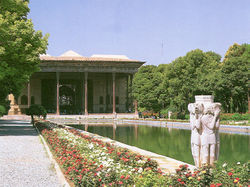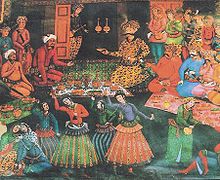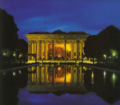- Chehel Sotoun
-
32°39′27.12″N 51°40′20.69″E / 32.6575333°N 51.6724139°E
Persian gardens * UNESCO World Heritage Site
Type Cultural Criteria i, ii, iii, iv, vi Reference 1372 Region ** Asia and Australasia Inscription history Inscription 2011 (35th Session) * Name as inscribed on World Heritage List
** Region as classified by UNESCOChehel Sotoun (also Chihil Sutun or Chehel Sotoon, Persian: چهل ستون, literally: “Forty Columns”) is a pavilion in the middle of a park at the far end of a long pool, in Isfahan, Iran, built by Shah Abbas II to be used for his entertainment and receptions. In this palace, Shah Abbas II and his successors would receive dignitaries and ambassadors, either on the terrace or in one of the stately reception halls.
The name, meaning "Forty Columns" in Persian, was inspired by the twenty slender wooden columns supporting the entrance pavilion, which, when reflected in the waters of the fountain, are said to appear to be forty.[1]
As with Ali Qapu, the palace contains many frescoes and paintings on ceramic. Many of the ceramic panels have been dispersed and are now in the possession of major museums in the west. They depict specific historical scenes such as a reception for an Uzbek King in 1646, when the palace had just been completed; a banquet in honor of the Emir of Bukhara in 1611; the battle of Chalderan against the Ottoman Sultan Selim I in 1514 in which the Persians fought without firearms; the welcome extended to the Mughal Emperor, Humayun who took refuge in Iran in 1544; the battle of Taher-Abad in 1510 where the Safavid Shah Ismail I vanquished and killed the Uzbek King. A more recent painting depicts Nader Shah's victory against the Indian Army at Karnal in 1739. There are also less historical, but even more aesthetic compositions in the traditional miniature style which celebrate the joy of life and love.
Contents
Photo gallery
-
As opposed to Ottoman architecture focusing on scale and grandeur, Safavid architecture considers itself more subtle. View of Chehel-sotoon Palace.
-
Wall painting, depicting a Chaharshanbe Suri celebration
See also
- Persian architecture (Particularly Achaemenid architecture)
- Islamic architecture
Notes
- ^ Landor, Arnold Henry Savage (1902). Across Coveted Lands. London: MacMillan and Co., Limited. p. 323. http://www.gutenberg.org/files/22117/22117-h/v1.html.
External links
World Heritage Sites in Iran The Armenian Monastic Ensembles of Iran (St Thaddeus Monastery, St Stepanos Monastery, Chapel of Dzordzor, Chapel of Chupan, and Church of the Holy Mother of God) · Bam and its Cultural Landscape · Bistoun · Chogha Zanbil · Naqsh-e Jahan Square · Pasargadae · Persepolis · The Persian Gardens (Pasargad Pserian, Chehel Sotoun, Fin, Eram, Shazdeh, Dolatabad, Abbasabad, Akbarieh and Pahlevanpour) · Sheikh Safi's Tomb · Soltaniyeh · Shushtar Historical Hydraulic System · Tabriz Bazaar · Takht-i-Suleiman
Architecture of Iran Styles Parsi style · (includes Pre-Parsi style and Achaemenid architecture)
Parthian style · (includes Sassanid architecture)
Khorasani style · Razi style · Azari style · Isfahani style
Elements Notable traditional cities Architecture of Tehran · Bam · Bukhara · Ctesiphon · Derbent · Herat · Isfahan · Kashan · Merv · Mashhad · · Nishapur · Persepolis · Qazvin · Qom · Samarkand · Shahrisabz · Shiraz · Susa · Tabriz · Takht-i-Suleiman · Yazd · Gur-e AmirTheory and Analysis Lists Categories:- World Heritage Sites in Iran
- Palaces in Iran
- Buildings and structures in Isfahan
- Safavid architecture
- 17th-century architecture
- Persian gardens
-
Wikimedia Foundation. 2010.










